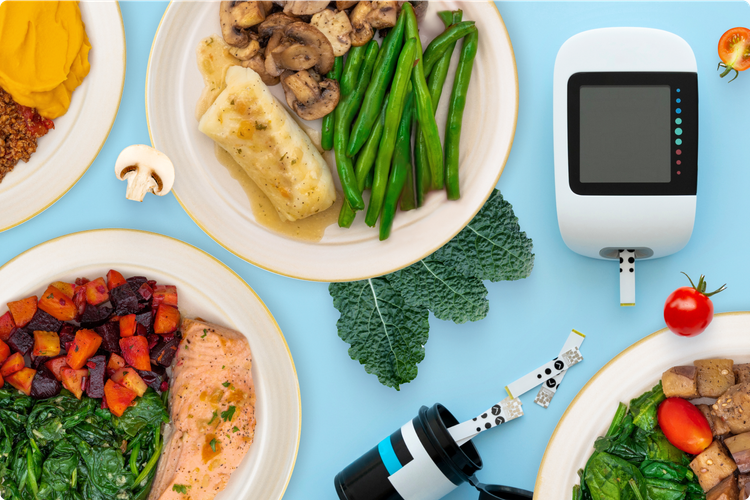
science
Glycemic Index for Diabetics: Essential Tips and Foods
Overview: The glycemic index diet ranks carbs by their impact on blood sugar. Low GI foods (≤55) digest slowly, stabilizing glucose and improving insulin sensitivity, while high GI foods (≥70) cause spikes. Choosing low GI options helps control diabetes, boost energy, and reduce health risks.
Understanding the Glycemic Index: A Vital Tool for Diabetes Management
Understanding the Glycemic Index (GI) may simplify the process of managing blood sugar. The GI ranks carbohydrates based on their effect on blood glucose levels. The GI is a numerical system that measures how fast and how high a particular food can raise blood glucose levels compared to pure glucose. Foods are ranked on a scale from 0 to 100.
Examples of the Glycemic Index:
- Low GI foods: 55 or less
- Medium GI foods: 56-69
- High GI foods: 70 or above
What Is the Glycemic Index?
The glycemic index (GI) is a scale that rates carbohydrates according to how quickly they release glucose into the bloodstream. Processed foods and high GI carbohydrates cause blood into the cells levels to rise rapidly, increasing risk factors for cardiovascular disease and diabetes. People with diabetes may benefit from lower GI food choices, which also affect the GI of meals.
The GI of foods can be influenced by the type of sugar and how the food is prepared. Foods like sweet corn and other healthy foods provide important nutrients while having a lower GI. The effect of low GI foods is seen in the next two hours as they cause a slower rise in blood sugar, aiding in diabetes care.
According to the Better Health Channel and Mayo Clinic, choosing foods that fit a dietary plan with a lower GI can also help manage current health topics related to diabetes care. Higher than foods with a lower GI, high GI carbohydrates should be consumed less frequently to maintain better health.
Importance and Benefits of the Glycemic Index for Diabetes Management
- Blood Sugar Control: Low GI foods lead to slower digestion and absorption, resulting in stable blood glucose levels.
- Insulin Sensitivity: Diets rich in low GI foods can improve insulin sensitivity, beneficial for type 2 diabetes.
- Reduced Complications: Managing blood sugar levels can reduce the risk of complications like heart disease and nerve damage.
- Satiety and Energy: They keep you full longer and provide consistent energy levels
- Examples of Low GI Foods: Apples, pears, broccoli, lentils, quinoa, and unsweetened yogurt.
High GI Foods to Avoid – Avoiding high GI foods is equally important:
- Examples of High GI Foods: White bread, sugary cereals, baked goods, sweetened beverages, and white rice.
- Impact: High GI foods cause rapid spikes in blood sugar, increased insulin demand, and energy fluctuations.
Strategies for Reducing High GI Foods – Manage blood sugar effectively:
- Choose Whole Grains: Opt for brown rice, quinoa, and whole oats.
- Increase Vegetables: Focus on non-starchy vegetables.
- Limit Sugary Snacks: Replace with nuts, seeds, and low GI fruits.
- Read Labels: Avoid hidden sugars and refined carbs.
Incorporating Low GI Foods into Your Diet
- Opt for Whole and Unprocessed Foods: Whole grains, fruits, and vegetables.
- Combine Foods Wisely: Pair high GI foods with low GI foods.
- Check Labels: Review the food and nutritional label for high GI ingredients.
- Use Substitutes: Replace high GI foods with healthier options.
Sample Meal Plans with Low GI Options – Incorporate LifeChef Health meals:
- Breakfast: Spinach and feta egg whites with fresh berries.
- Lunch: Moroccan chicken, roasted root vegetables and steamed broccoli.
- Dinner: Grilled salmon, roasted Brussels sprouts and immune boosting quinoa.
- Snack: Apple with natural peanut butter.

Conclusion
The glycemic index is a powerful tool for managing diabetes. By choosing low GI foods, you can control blood sugar levels, improve insulin sensitivity, and reduce the risk of complications. By understanding the glycemic index and making mindful food choices, you can achieve visible and lasting health gains while enhancing your overall sense of wellness.
Start your journey to better health with LifeChef Health today. Take control of your health now! Book a consultation with our LifeChef Health’s nutritionist for personalized meal plans. Click here to schedule your appointment now.
Frequently Asked Questions
Glycemic Index vs. Glycemic Load
The Glycemic Index (GI) is a scale that ranks how quickly carbohydrate-containing foods raise blood sugar levels. In contrast, Glycemic Load (GL) considers both the GI and the portion size, offering a more comprehensive view.
According to the Mayo Clinic, understanding both GI and GL can help a patient make informed dietary choices for better blood sugar management.
What is the glycemic index and why is it important for diabetes management?
The glycemic index is a ranking system that rates carbohydrates in foods and drinks based on how quickly they affect blood sugar levels. It is crucial for diabetes management because it helps individuals understand which foods will cause a rapid increase in blood glucose. By choosing foods with a low glycaemic index, a person with diabetes can better control their blood glucose level and reduce the risk of complications associated with type 2 diabetes.
How does the glycemic index differ from the glycemic load?
While the glycemic index measures how quickly a food raises blood sugar levels, the glycemic load takes into account the amount of carbohydrates in a serving of food. This means that glycemic load provides a more comprehensive picture of how a food will affect blood glucose. For example, a food might have a high GI but a low glycemic load if it contains a small amount of carbohydrates.
What are some examples of low gi foods that are beneficial for people with diabetes?
Examples of low gi foods include most fruits and vegetables, legumes, whole grains, and dairy products. Foods like lentils, chickpeas, apples, and yogurt have a low glycemic index and may help maintain stable blood glucose levels. Incorporating these foods into a diabetes treatment plan can support better blood sugar management.
Why is it important to avoid high GI foods if you have diabetes?
For people with type 2 diabetes, it is crucial to avoid foods with a high glycemic index and glycemic load as they can increase blood glucose levels rapidly. The glycemic index (GI) ranks food on a scale from 0 to 100 based on how quickly it increase blood sugar levels. Foods that contain high in carbohydrates, like a small baked potato, have a higher glycaemic index and can lead to a quick rise in blood sugar. A systematic review and meta-analysis by the Department of health suggests that eating low GI foods can improve well-being to improve health outcomes.
Incorporating a low-glycemic index diet can help people with diabetes manage their condition effectively. Foods increase blood sugar at different rates, and moderate to high GI foods are digested and absorbed more quickly into the bloodstream, leading to a rapid increase in blood glucose levels. A low GI rating food, such as an unripe banana, may have a lower gi compared to a ripe one. According to Diabetes Canada and the Mayo Clinic staff, a low GI product like an apple is low in GI and can be beneficial for healthy eating.
Incorporating low glycemic index foods into one’s diet may lower the GI value of meals, helping to control blood sugar levels. A systematic review has shown that index diets as an intervention can positively affect the gi and affect on health. The GI of a food can be influenced by how it is prepared and combined with other foods. For instance, pairing a higher gi food with a low gi option can help lower the gi of the entire meal. Consulting a registered health professional can provide personalized



